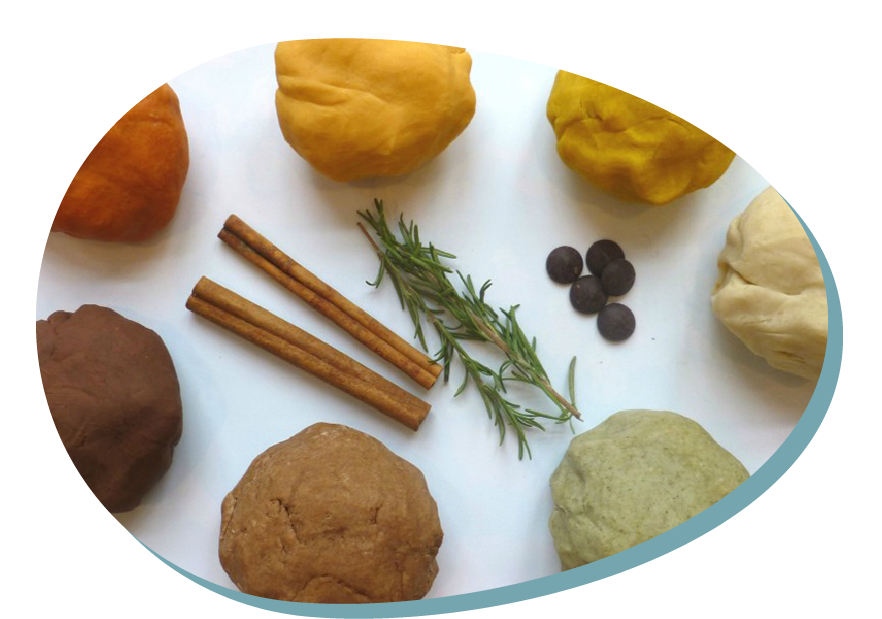Homemade Herb and Spice Playdough
Type of resource Website – Document – Video
Web address https://craftulate.com/homemade-herb-and-spice-play-dough
Language: English
Description
Exploring herbs, spices and mixing by making playdough.
Scientific concept introduced
Exploring mixing
Investigating plant life (spices and herbs)
Exploring with the senses
Creative and critical thinking
Critical Thinking:
Inference
Creative Thinking:
Making
Mathematical reasoning
Measuring using non-standard units
Scientific thinking
Questioning
Observing
Exploring
Recording
Analysising
Drawing conclusions
Learning how to learn
Following guidelines
Turn taking in groups
Additional
Cooking skills of stirring, kneading and mixing
Oral language – listening and following instructions
Collaborative skills through group Work
Hand-eye coordination
Literacy – vocabulary development
Homemade Herb and Spice Playdough
Overall aims
To enable pupils to use their senses to explore herbs and spices
To develop pupils’ skills in listening and following instructions
To develop pupils’ cooking skill of stirring and kneading
To develop pupils’ fine motor skills
To develop pupils’ skills in observing
To develop pupils’ skills in recording
To develop pupils’ skills in measuring
Vocabulary – keywords should be understood
Spices, herbs, plant, flavour, season, flour, mix, stir, ingredients, dough, knead, mixture, smooth
Expected learning outcomes (operational aims)
The child will be enabled to:
– follow instructions for making dough
– explore how the ingredients mix together
– practice stirring and kneading
– make observations about how ingredients combine
– work together in small groups
– record their results
STEM skills – to which the learning unit is related to
CORE STEM SKILLS
Asking questions
Observing
Exploring
Measuring
Making
Analyzing the results involved in the process of making dough
Drawing conclusions
ADDITIONAL SKILLS
Hand-eye coordination
Fine-motor skills
Writing
Reading
Oral Language
Cooking skills of stirring and mixing
Following rules of safety
Group work
Teaching methodologies/activity outline
Introduction
Before you begin, ask pupils what they understand by the words ‘spices’ and ‘herbs’.
Explain that a spice is any dried part of a plant except for the leaves. An herb is any green or leafy part of a plant. Spices and herbs are used to flavour and season food but they’re not used as the main ingredient.
Elicit pupils’ prior knowledge and experience of spices and herbs. Use a spider diagram to note comments.
Sample Questions: Can you name any spices/herbs? Have you ever tasted any spices/herbs? What did they taste like? Did you like them?
Inform pupils that they are going to make their own play dough using some spices and herbs.
Activity
Ask pupils to work in groups, each group using a different spice to make their own dough ball.
Ingredients
(For one batch)
– ½ cup plain flour
– ½ cup water
– 2 tbsp. salt
– 1 tsp cream of tartar
– Herbs and spices
Herb and Spice Quantity Recommendation:
– Paprika 1 tbsp.
– Cocoa powder 1 – 2 tbsp.
– Ground Cinnamon 1 tbsp.
– Ground Rosemary 2 tbsp.
– Cheddar Cheese powder 1 tbsp.
– Ground Tumeric 1.5 tbsp.
– Mild Mustard Powder 1-2 tbsp.
Instructions
1. Add all the ingredients into a saucepan and mix well until the mixture is smooth but it’s okay if there are a few little lumps.
2. Place over a low to medium heat and cook. Stir constantly to make sure the dough forms into a ball.
3. Place dough ball onto wax paper and let cool.
4. Then knead until smooth.
5. Discuss what happened in making the dough. Also compare the different dough balls using the senses:
Sample Questions: What did you do with the ingredients? (Stirred them together) / What happened to the ingredients? (They mixed together). What do you think would happen if you added to much water? What does your dough ball look/feel like? Describe the smell.
Teacher note: A chemical reaction happens when you mix all ingredients
Conclusion
Ask children to write/draw the steps they took to make their dough.
Assessment of learning
Pupil observation sheet
Equipment and materials to be used in learning unit (tools, ingredients etc)
Saucepan
Wax paper
Spoons
Kind of setting
Kitchen or classroom with cooking facilities (ie hot stove)
References – source
Website: https://craftulate.com/homemade-herb-and-spice-play-dough
Supporting Video on how to make play dough: https://youtu.be/meg48-shCCM
Homemade Herb and Spice Playdough
1. Usefulness for STEM education – integrating content of different disciplines
Cross-curricular character of the resource

The range of S-T-E-M subjects included

The presentation of possibilities of including artistic activities (STEAM approach)

2. Expected learning outcomes
Consistency (links) with preschool core curriculum

Communicativeness of description

3. Methodology of teaching
Clarity, communicativeness of instructions for teachers

Meaningful learning – using practical life problems

Original idea

The level of ease in implementing the methodology to preschool age children

The level of ease in preparing necessary ingredients, materials and equipment needed

4. Sustainability
Ecological characteristics of materials/ results

Supporting healthy eating habits

Low ecological footprint

Possibilities of inclusion (respecting cultural diversity and food intolerances)

5. Class management
Using differentiated forms of work – individual, team work etc.

Individual work

Team work

Whole group
6. Time management

Short activity (10-15 minutes)

Medium activity (20-30 minutes)

Long activity (1 hour or more)

Very long activity (1 day or more)
PDF: https://www.printfriendly.com/p/g/Jiq7NA

